Glass catfish are a popular freshwater aquarium fish that are known for their unique appearance and peaceful nature. These fish are transparent, which makes them a fascinating addition to any aquarium. However, caring for glass catfish can be a bit challenging, especially if you are new to fishkeeping.
Glass catfish require a well-maintained aquarium with suitable water conditions, a varied diet, and a peaceful environment. They need a pH range of 6.0-7.5 and a temperature range between 75-82°F. The aquarium should be planted, and regular water changes should be performed to ensure their health. They are peaceful and active fish, making them a popular choice for community tanks.
In this article, we will cover everything you need to know about caring for glass catfish. We’ll discuss their habitat requirements, feeding habits, and common health issues. Whether you’re a seasoned fishkeeper or a beginner, this guide will provide you with all the information you need to keep your glass catfish healthy and happy.
As a fish enthusiast myself, I understand the importance of providing the best care possible for our aquatic pets. Glass catfish are no exception. They require specific conditions to thrive, and it’s our responsibility to ensure that those conditions are met. So, let’s dive in and learn how to care for these fascinating fish!
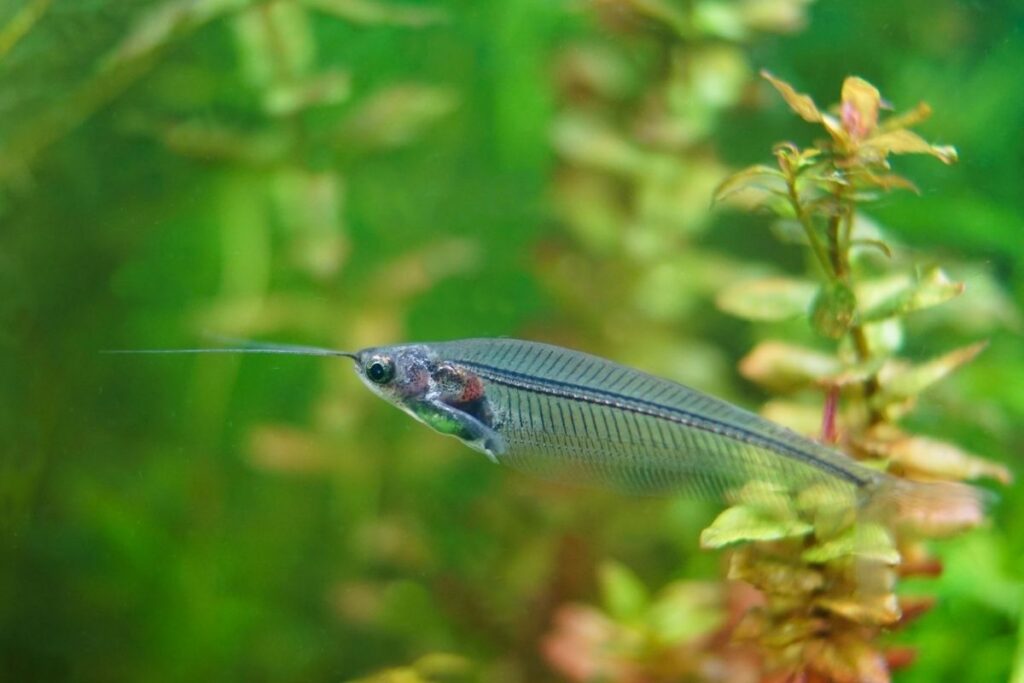
Table of Contents
Species Summary
Origin
Glass Catfish, also known as Kryptopterus bicirrhis, are native to Southeast Asia, specifically Thailand, Malaysia, and Indonesia.
They are commonly found in slow-moving rivers, streams, and swamps.
Lifespan
Glass Catfish have an average lifespan of 5-8 years. However, with proper care and a healthy environment, they can live up to 10 years.
Appearance
Glass Catfish are transparent fish that have a unique appearance. They have a long, slender body with a forked tail and two pairs of barbels near their mouth.
These barbels help them navigate their environment and find food.
Size
Glass Catfish can grow up to 6 inches in length.
However, they are slow growers and take a few years to reach their full size.
Growth rate
Glass Catfish are slow growers and can take up to 2-3 years to reach their full size.
It is important to provide them with a healthy environment and a balanced diet to promote their growth.
Behavior & Temperament
Glass Catfish are peaceful and social fish that thrive in groups. They are active swimmers and enjoy exploring their environment.
However, they are also sensitive fish that can be easily stressed by sudden changes in their environment.
Personally, I have found that Glass Catfish are fascinating fish to observe. I have a group of 6 in my aquarium, and they are always swimming together and exploring their surroundings. They are a great addition to any community tank and can add a unique touch to your aquarium.
Habitat and Tank Requirements
Tank Size
Glass catfish are schooling fish and require a minimum tank size of 20 gallons.
I personally keep a group of six Glass catfish in a 40-gallon tank, which gives them plenty of space to swim and play.
Lighting
While Glass catfish don’t require special lighting, it’s important to provide a consistent light cycle.
I recommend setting a timer for 8-10 hours of light per day, which mimics their natural environment.
Filtration and Aeration
A good filtration system is essential for keeping the tank clean and maintaining water quality.
I use a hang-on-back filter and a sponge filter for extra aeration. It’s important to avoid strong currents, as Glass catfish are not strong swimmers.
Heater
Glass catfish are tropical fish and require a water temperature between 75-82°F.
A reliable heater is necessary to maintain a consistent temperature in the tank.
Substrate
Glass catfish prefer a sandy substrate, as it mimics their natural environment and allows them to forage for food.
I recommend a fine-grain sand, as larger grains can damage their delicate barbels.
Decoration
Glass catfish are shy fish and require plenty of hiding places to feel secure.
I like to provide a variety of decorations, such as caves, driftwood, and rocks. Avoid sharp or jagged decorations, as they can injure the fish.
Plants
Live plants not only provide hiding places for Glass catfish but also help maintain water quality by absorbing nitrates.
I recommend hardy plants such as Java fern, Anubias, and Amazon sword.
Overall, providing a suitable habitat and tank requirements is crucial for the health and well-being of Glass catfish.
By following these guidelines, you can create a beautiful and thriving environment for your fish to call home.
Water Quality
Water Temperature
Glass catfish are sensitive to temperature changes, so it’s essential to keep the water temperature consistent.
The ideal temperature range for glass catfish is between 75 to 80 degrees Fahrenheit.
I’ve found that maintaining a stable temperature is easier with a heater and thermometer, which allows me to monitor the temperature and adjust it accordingly.
Water pH
Glass catfish prefer a slightly acidic environment, with a pH range of 6.0 to 7.5. I use a pH test kit to check the water regularly and adjust it if necessary.
It’s essential to avoid sudden changes in pH levels, as this can stress out the fish and make them more susceptible to diseases.
Water Hardness
Glass catfish prefer soft to moderately hard water, with a hardness range of 5 to 12 dGH. I use a water hardness test kit to check the water regularly and adjust it if necessary.
If the water is too hard, I add some distilled water to the tank to lower the hardness level.
Water Changes
Regular water changes are crucial to maintaining a healthy environment for glass catfish. I change 25% of the water in the tank every week, using a siphon to remove any debris and waste from the gravel.
It’s essential to avoid changing too much water at once, as this can shock the fish and disrupt the balance of the tank.
By ensuring that the water temperature, pH, and hardness are within the ideal range and performing regular water changes, you can provide a healthy environment for your glass catfish.
Remember to monitor the water quality regularly and adjust it if necessary to keep your fish happy and healthy.
Personally, I’ve found that maintaining a consistent water quality has helped my glass catfish thrive. I used to struggle with keeping the water temperature stable, but investing in a heater and thermometer made a significant difference.
It’s also essential to be patient when adjusting the water quality, as sudden changes can stress out the fish. With a little effort and attention to detail, you can provide a comfortable and healthy home for your glass catfish.
Feeding Glass Catfish
Diet
Glass catfish are omnivores, which means they will eat both plant and animal-based food. They are not picky eaters and will eat almost anything you give them.
However, it is important to provide them with a balanced diet to ensure their health and longevity.
I personally feed my glass catfish a mixture of commercial fish flakes and frozen brine shrimp.
I also occasionally give them live food such as daphnia or bloodworms, which they love. You can also provide them with small pieces of vegetables such as blanched spinach or zucchini.
Feeding Schedule
It is recommended to feed your glass catfish twice a day, once in the morning and once in the evening. However, you can adjust the feeding schedule based on their appetite and behavior.
If they are not eating all the food you give them, reduce the amount and frequency of feeding.
It is important not to overfeed your glass catfish as they have a tendency to eat more than they need. Overfeeding can lead to health problems such as obesity and digestive issues.
A good rule of thumb is to feed them the amount of food they can consume in 2-3 minutes.
Another important thing to remember is to remove any uneaten food after feeding.
This will prevent the food from decomposing and polluting the water, which can lead to health issues for your fish.
In conclusion, feeding your glass catfish a balanced diet and following a regular feeding schedule will ensure their health and happiness. By providing them with a variety of food options and monitoring their appetite, you can keep them healthy and thriving.
Glass Catfish Behavior
Social Behavior
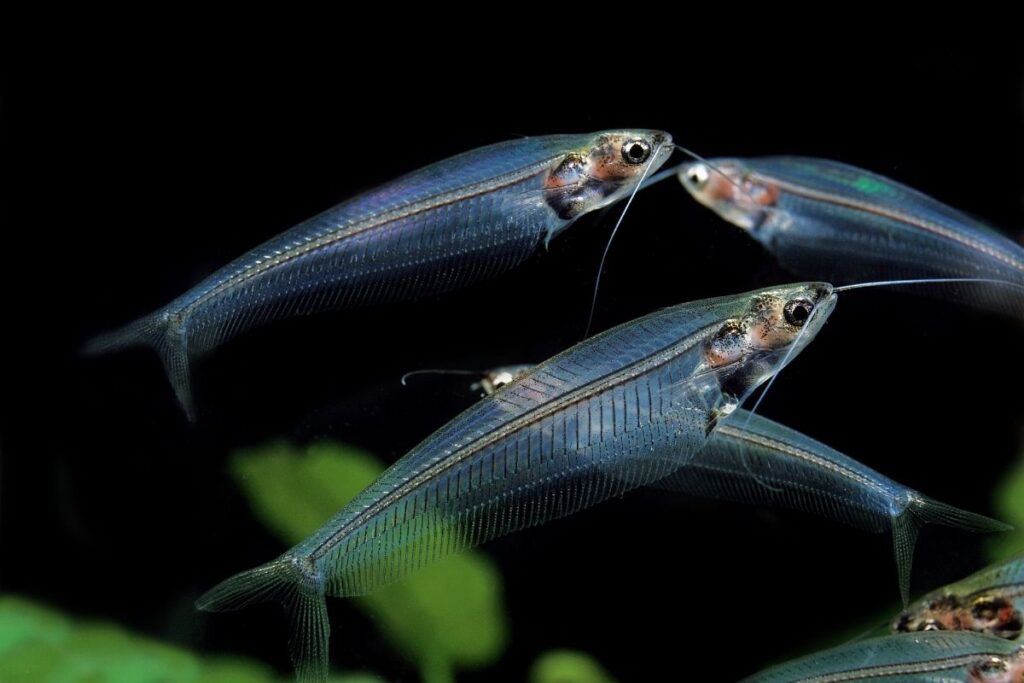
Glass catfish are peaceful and social creatures that prefer to live in groups. In the wild, they form large shoals of up to hundreds of individuals.
When kept in captivity, they should be kept in groups of at least six individuals to prevent stress and promote natural behavior.
They are active swimmers and love to explore their surroundings. They are also known to be active during the day and night, so it’s important to provide them with plenty of hiding places and a well-lit aquarium.
Compatibility with Other Fish
Glass catfish are generally peaceful and can be kept with other peaceful fish species.
They are not aggressive and will not harm other fish, but they may be intimidated by larger or more aggressive fish.
It’s important to choose tankmates that are similar in size and temperament to prevent any conflicts.
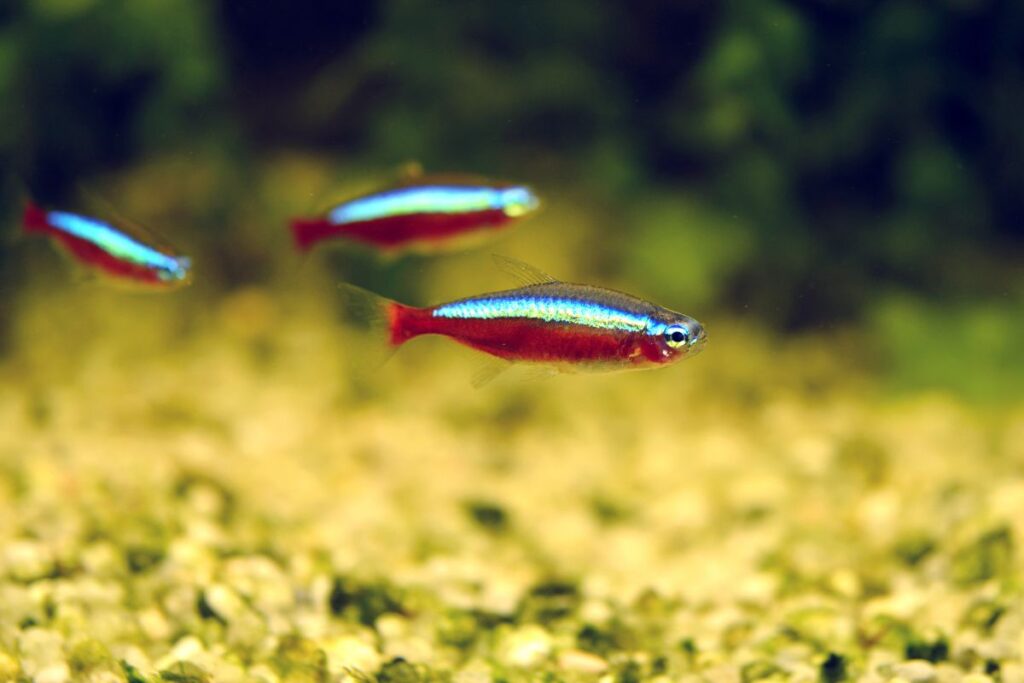
Some good tankmates for glass catfish include tetras, rasboras, and guppies.
How Many Glass Catfish Should be Kept Together
Glass catfish are social creatures and should be kept in groups of at least six individuals. Keeping them in smaller groups may cause stress and lead to health problems.
It’s important to provide enough space for each fish, so a minimum tank size of 20 gallons is recommended for a group of six glass catfish.
A larger tank will provide more swimming space and allow for a greater number of fish.
Signs of Stress
Glass catfish are sensitive to changes in their environment and may exhibit signs of stress if they are not kept in suitable conditions.
Some signs of stress include loss of appetite, lethargy, hiding, and rapid breathing.
It’s important to monitor their behavior and water parameters regularly to ensure they are healthy and happy.
Personally, I have found that glass catfish are fascinating to watch and have a unique personality. They are very active and enjoy swimming together in a group. I have kept them with other peaceful fish species and have found that they get along well. It’s important to provide them with a suitable environment to ensure they thrive.
Glass Catfish Health
Common Diseases
Glass catfish are generally hardy and disease-resistant fish. However, they are still susceptible to some common fish diseases such as:
- Ich (white spot disease)
- Fin rot
- Columnaris
If you notice any of these symptoms, such as white spots on the fish’s body, ragged fins, or cotton-like growths, take action immediately to prevent the disease from spreading to other fish in the tank.
Prevention
Prevention is key to keeping your glass catfish healthy. Here are some tips:
- Keep the water clean and properly filtered.
- Avoid overcrowding the tank.
- Quarantine new fish before introducing them to the tank.
- Feed your fish a balanced diet.
By following these tips, you can help prevent diseases from affecting your glass catfish.
Treatment
If your glass catfish does become sick, there are several treatment options available:
- Medications: There are a variety of medications available to treat common fish diseases. Follow the instructions carefully and continue treatment until the fish has fully recovered.
- Isolation: If the disease is contagious, it may be necessary to isolate the sick fish to prevent it from spreading to other fish in the tank.
- Water changes: Regular water changes can help keep the tank clean and prevent the spread of disease.
Remember that prevention is the best medicine, so take steps to keep your glass catfish healthy and disease-free.
Personally, I once had a glass catfish that developed fin rot. I immediately isolated it and treated it with medication. After a few days, the fish showed signs of improvement and eventually made a full recovery. It’s important to keep a close eye on your fish and take action at the first sign of illness.
Signs of a Healthy Glass Catfish
Glass catfish are beautiful and fascinating creatures that require proper care to thrive. Here are some signs to look for to ensure your glass catfish is healthy:
- Clear and Bright Eyes: The eyes of a healthy glass catfish are clear and bright, without any cloudiness or discoloration.
- Active Behavior: Healthy glass catfish are active and swim around their tank, exploring and playing with their tank mates.
- Good Appetite: A healthy glass catfish has a good appetite and eagerly eats its food. If you notice a decrease in appetite, it could be a sign of illness.
- Smooth and Shiny Skin: The skin of a healthy glass catfish is smooth and shiny, without any bumps, lumps, or discoloration.
- Clear and Clean Fins: The fins of a healthy glass catfish are clear and clean, without any tears, frays, or signs of infection.
When I first got my glass catfish, I was worried about its health and well-being. I spent a lot of time researching and learning about the signs of a healthy glass catfish.
By observing my glass catfish every day, I was able to identify these signs and ensure that it was happy and healthy.
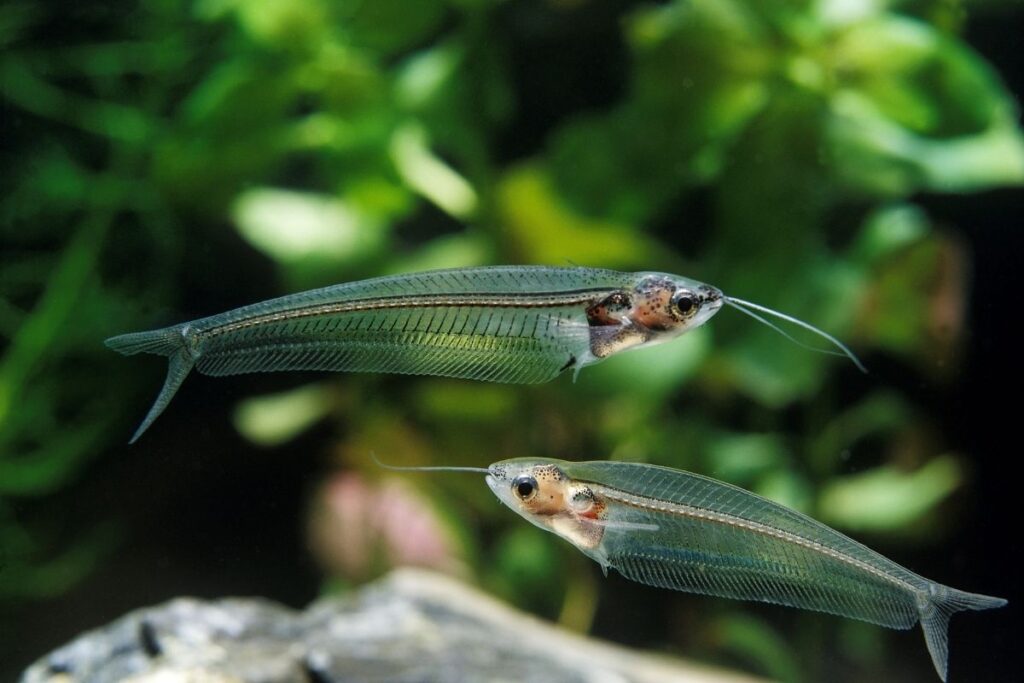
If you notice any signs of illness or discomfort in your glass catfish, it’s important to take action quickly.
Consult with a veterinarian or experienced fish keeper to determine the best course of action for your beloved pet.
Signs of a Sick Glass Catfish
As a glass catfish owner, it is important to be able to identify when your fish is not feeling well. Here are some common signs that your glass catfish may be sick:
- Loss of appetite
- Sluggish or lethargic behavior
- Discoloration or spots on their body
- Abnormal swimming patterns or difficulty swimming
- Rapid breathing or gasping for air at the surface
If you notice any of these symptoms, it is important to take action quickly to prevent the illness from worsening.
Personally, I once had a glass catfish that was not swimming normally and seemed to be struggling to stay afloat. I immediately checked the water parameters and found that the ammonia levels were high.
After doing a partial water change and adding some beneficial bacteria, my glass catfish was back to its normal self within a few days.
Remember, prevention is key when it comes to keeping your glass catfish healthy. Regular water changes and proper filtration can go a long way in preventing illnesses from occurring in the first place.
Breeding Glass Catfish
Breeding glass catfish can be a rewarding experience for fish enthusiasts. Here are some tips on how to successfully breed glass catfish.
Breeding Setup
To breed glass catfish, you will need a separate breeding tank. The breeding tank should be at least 10 gallons in size and have a sponge filter to prevent the fry from being sucked up.
You will also need plants or spawning mops for the glass catfish to lay their eggs on. The water temperature should be around 78°F and the pH should be neutral.
Breeding Process
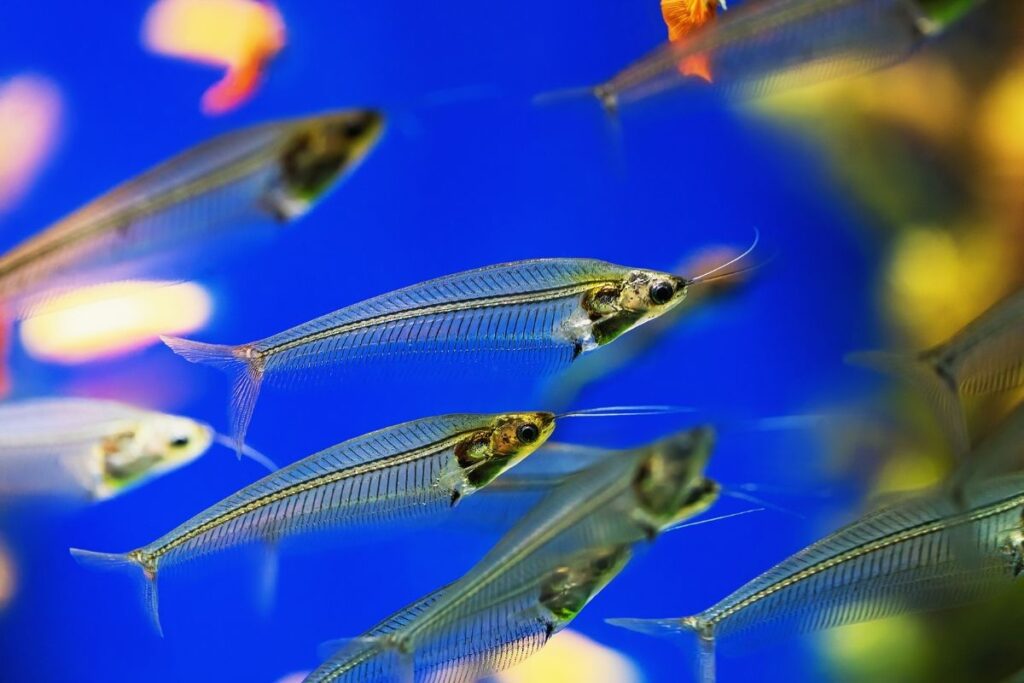
To initiate breeding, it is best to have a group of 6-8 glass catfish in the breeding tank. The males will begin to chase the females around the tank and display their fins.
Once the female is ready to lay eggs, she will lay them on the plants or spawning mops. The male will then fertilize the eggs.
How to Tell if a Glass Catfish is Pregnant
It can be difficult to tell if a glass catfish is pregnant, but one way to tell is by looking at their belly.
If the belly is slightly rounded and the fish appears to be carrying eggs, then it is likely pregnant. Another way to tell is by observing the behavior of the fish.
Pregnant glass catfish may become more reclusive and less active.
Raising Fry
Once the eggs have been fertilized, they will hatch in about 24-36 hours. The fry will be very small and will need to be fed small amounts of infusoria or liquid fry food.
As they grow, you can gradually increase the size of their food. It is important to keep the water clean and perform frequent water changes to ensure the fry stay healthy.
I have personally bred glass catfish and found it to be a fascinating experience. Watching the males display their fins and the females lay their eggs was truly captivating.
With the right setup and care, breeding glass catfish can be a fun and rewarding hobby.
Product Recommendation:
- Aqueon LED Aquarium Kit– This aquarium LED kit provides a consistent light cycle for your Glass Catfish, which mimics their natural environment. It also includes a heater and filter to maintain a healthy environment for your fish.
- CaribSea Super Naturals Aquarium Sand – This fine-grain sand substrate is perfect for Glass Catfish, as it mimics their natural environment and allows them to forage for food.
- API Freshwater Master Test Kit – This water quality test kit allows you to monitor the pH, hardness, and other parameters of your tank water, ensuring that it is within the ideal range for Glass Catfish.
- TetraMin Plus Tropical Flakes– This balanced fish food provides all the necessary nutrients for your Glass Catfish, ensuring their health and longevity.
- Seachem Prime Fresh and Saltwater Conditioner – This water conditioner helps to detoxify harmful chemicals in the water, ensuring a healthy environment for your Glass Catfish.
- Penn-Plax Aquarium Decoration – This aquarium decoration provides hiding places for your Glass Catfish, which helps them feel secure and reduce stress. This decoration is made of non-toxic resin and is safe for your fish.
- Aqueon Aquarium Fish Tank Starter Kit – This kit includes a 20-gallon glass aquarium, a LED hood, a QuietFlow filter, a heater, and a fishnet. It also comes with a setup guide to help you get started.
- Hikari Freeze Dried Daphnia – This freeze-dried daphnia is a great source of protein for your Glass Catfish. It is easy to feed and provides a variety in their diet.
- Marina Floating Thermometer – This floating thermometer helps you monitor the water temperature in your tank, ensuring that it is within the ideal range for your Glass Catfish.
- API Stress Coat Water Conditioner – This water conditioner helps to reduce stress in your Glass Catfish, promoting their health and well-being. It also helps to remove harmful chemicals from the water.
Conclusion
After spending countless hours researching and caring for my own glass catfish, I can confidently say that they are a fascinating and rewarding fish to have as a pet. With their unique transparent bodies and peaceful nature, they make a great addition to any aquarium.
Remember to provide a well-maintained tank with plenty of hiding spots and a varied diet. Keep an eye on their behavior and health, and don’t hesitate to seek advice from a professional if needed.
Overall, caring for glass catfish requires a bit of effort and attention, but the reward is well worth it. Watching them glide gracefully through the water is a truly mesmerizing experience, and I highly recommend giving these beautiful fish a chance in your own aquarium.
FAQs
As a fish owner, it is common to have questions about the care of your fish. Here are some frequently asked questions about glass catfish:
Q: Do glass catfish need a lot of space?
A: Yes, glass catfish need plenty of swimming room. A 30-gallon tank is recommended for a small school of glass catfish. They are active swimmers and need plenty of room to move around.
Q: What should I feed my glass catfish?
A: Glass catfish are omnivores and will eat a variety of foods. They enjoy live or frozen foods such as brine shrimp, bloodworms, and daphnia. They will also eat flake and pellet foods. It is important to provide a varied diet to ensure they receive all the necessary nutrients.
Q: Can I keep glass catfish with other fish?
A: Yes, glass catfish are peaceful and can be kept with other peaceful fish. They do well in a community tank with other small fish such as tetras and guppies. Avoid keeping them with larger, aggressive fish that may bully or eat them.
Q: How can I tell if my glass catfish is healthy?
A: A healthy glass catfish will have clear, bright eyes and a shiny, smooth body. They should be active and swimming around the tank. Look for any signs of illness such as lethargy, loss of appetite, or abnormal behavior. If you notice any of these signs, consult with a veterinarian who specializes in fish.
Personally, I had a glass catfish named Sparky who lived for over 5 years. He was a curious little fish who loved to follow my finger whenever I would tap on the glass. He was a joy to watch and care for, and I learned a lot about fish keeping from him.
Reference: Wikipedia.
